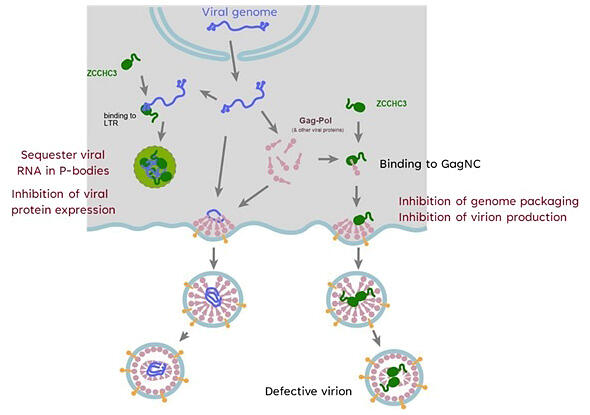A research group led by Associate Professor Akatsuki Saito of the Faculty of Agriculture at the University of Miyazaki and Associate Professor Shigehiro Yoshimura of the Graduate School of Biostudies at Kyoto University has identified "ZCCHC3" as a new host factor that inhibits human immunodeficiency virus (HIV) proliferation and clarified the action mechanism of the protein. ZCCHC3, which contains a zinc finger motif, was found to prevent HIV proliferation by inhibiting at least two steps in the virus replication cycle. These findings are expected to lead to a new HIV control method and were published in iScience on February 17.

Provided by the University of Miyazaki
HIV, classified as a retrovirus, is the causative virus of acquired immunodeficiency syndrome (AIDS). In recent days control of the disease using excellent antiviral drugs is now becoming possible. However, it is also known that once infected, virus removal from the body is extremely difficult. HIV has accessory proteins (e.g., Vpu and Nef) that are not found in normal retroviruses. These proteins are known to antagonize cellular proteins that inhibit virus proliferation. The research group aimed to identify host factors that are not antagonized by the HIV accessory proteins and analyze them using bioimaging and proximity-dependent biotin identification methods.
As a result, they found that zinc finger CCHC domain-containing protein 3 (ZCCHC3), a protein with a zinc finger motif, is a strong host factor that inhibits HIV proliferation. This protein showed an infection-inhibiting effect not only against HIV but also toward a wide range of retroviruses, including simian immunodeficiency virus. ZCCHC3 exerts its effect by binding to both Gag (a viral particle-forming protein) and viral genomic RNA. The domain in which the Zn finger motif is located, at the carboxyl terminal of the protein, is important for binding to Gag, thereby inhibiting its uptake into the virus.
HIV, an enveloped virus, has a structure surrounded by a lipid membrane. The particle-forming protein Gag serves as a scaffold by forming a multimer, which takes up viral RNA to form a new virus. Furthermore, the research group found that the central domain of ZCCHC3 binds to viral genomic RNA and brings it into the P-body, a particulate structure present in the cytoplasm of host cells, thereby preventing the uptake of viral genomic RNA into new virus particles. The expression of viral proteins was inhibited in these ways.
The mechanism of HIV growth inhibition by ZCCHC3 is different from that of any known HIV growth-inhibiting host factors. The research group found that ZCCHC3 has at least two effects: inhibiting virus production and reducing virus infectivity. ZCCHC3 is conserved among a wide range of mammals, and similar genes are present in amphibians. Accordingly, the protein may have an important function in evolutionary biology. In the future, the research group will proceed with the functional analysis of ZCCHC3 derived from animals other than humans. They will also study its mechanism of eliminating persistently infectious viruses and aim to develop a modified version of ZCCHC3 with even stronger antiviral effects as well as a highly efficient gene therapy using lentiviral vectors.
Saito said, "In the collaboration with Dr. Yoshimura of Kyoto University, we have clarified the action mechanism of ZCCHC3, a protein that strongly inhibits the proliferation of HIV. Although it took a long time since there were many points to be clarified, students and domestic and international collaborators helped us to publish the paper. Looking toward the future, we hope to leverage the characteristics of ZCCHC3, which targets multiple steps in HIV replication, to develop new treatments against HIV infection."
Journal Information
Publication: iScience
Title: Host ZCCHC3 blocks HIV-1 infection and production through a dual mechanism
DOI: 10.1016/j.isci.2024.109107
This article has been translated by JST with permission from The Science News Ltd. (https://sci-news.co.jp/). Unauthorized reproduction of the article and photographs is prohibited.




